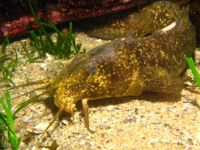Difference between revisions of "Cnidoglanis macrocephalus"
From The Aquarium Wiki
m |
|||
| Line 36: | Line 36: | ||
|max_water_hardness=12 | |max_water_hardness=12 | ||
}} | }} | ||
| − | + | ||
| − | + | == Origin == | |
| − | + | :Endemic to Australia. Present along both eastern and western Australian coasts, from Kirra in southern Queensland to Jervis Bay in New South Wales, and from Kingston in South Australia to the Houtman Abrolhos in Western Australia. | |
| − | + | ||
| − | + | ||
| − | + | == Sexing == | |
| − | + | :Difficult to visually sex. Are not captive bred. | |
| − | + | ||
| − | + | ||
| − | + | == Tank compatibility == | |
| + | :A large yet generally peaceful fish that should work with similar sized robust tank mates. As juveniles they don't seem to mind their own kind but adults prefer to be solitary. They will eat inverts however and are best in very large fish-only set ups. | ||
| + | |||
| + | |||
| + | == Diet == | ||
| + | :Prefers meaty foods such as krill, shrimp etc. | ||
| + | |||
| + | |||
| + | == Feeding regime == | ||
| + | :Feed once or twice a day. | ||
| + | |||
| + | |||
| + | == Environment specifics == | ||
| + | :An inshore marine species which lives in shallow bays and sandy inlets near river mouths. Found most frequently over sand, rocks and weeds in clear to turbid waters. Needs a very large set up with large hiding places in rock work. They thrive best in marine set ups rather than brackish and tanks should be mature and well filtered. | ||
| + | |||
| + | |||
| + | == Behaviour == | ||
| + | :A generally peaceful very large catfish that prefers to hide during the day. | ||
| + | |||
| + | |||
| + | == Identification == | ||
| + | :A large bodied catfish with a broad head and 4 sets of [[barbel]]s around the head. They have a fairly striking colouration, with dark brown base mottled with yellow/orange spots. | ||
| + | |||
| + | |||
{{Categories | {{Categories | ||
|Category=Fish, Fish (Brackish), Sea Catfish, Catfish, Sea Catfish, Fish (Saltwater), Sea Catfish, Monster Fish | |Category=Fish, Fish (Brackish), Sea Catfish, Catfish, Sea Catfish, Fish (Saltwater), Sea Catfish, Monster Fish | ||
Latest revision as of 03:21, 13 December 2017
Estuary Catfish
Cnidoglanis macrocephalus
757 Litres (200 US G.)
61-88.9cm (24-35 ")
8.0 - 8.6
20-25°C (68 -77 °F)
8-12 °d
1:1 M:F
8-12 years
Family
Plotosidae
Contents
Additional names
- Estuary Catfish, Cobbler
Additional scientific names
- Plotosus macrocephalus, Choeroplotosus decemfilis, Choeroplotosus limbatus
Origin[edit]
- Endemic to Australia. Present along both eastern and western Australian coasts, from Kirra in southern Queensland to Jervis Bay in New South Wales, and from Kingston in South Australia to the Houtman Abrolhos in Western Australia.
Sexing[edit]
- Difficult to visually sex. Are not captive bred.
Tank compatibility[edit]
- A large yet generally peaceful fish that should work with similar sized robust tank mates. As juveniles they don't seem to mind their own kind but adults prefer to be solitary. They will eat inverts however and are best in very large fish-only set ups.
Diet[edit]
- Prefers meaty foods such as krill, shrimp etc.
Feeding regime[edit]
- Feed once or twice a day.
Environment specifics[edit]
- An inshore marine species which lives in shallow bays and sandy inlets near river mouths. Found most frequently over sand, rocks and weeds in clear to turbid waters. Needs a very large set up with large hiding places in rock work. They thrive best in marine set ups rather than brackish and tanks should be mature and well filtered.
Behaviour[edit]
- A generally peaceful very large catfish that prefers to hide during the day.
Identification[edit]
- A large bodied catfish with a broad head and 4 sets of barbels around the head. They have a fairly striking colouration, with dark brown base mottled with yellow/orange spots.
Pictures[edit]
External links[edit]
- Fishbase (Mirrors:
 )
)
